It wasn’t until I started growing my own vegetables I even clocked that purple sprouting broccoli existed. In the supermarkets you can readily buy the green types and I had – wrongly – assumed these were just normal broccoli, picked younger or something. In fact, sprouting broccoli is an entirely distinct cultivar in the Brassica family, closely related but those long spear like shoots have been bred by humans intentionally.
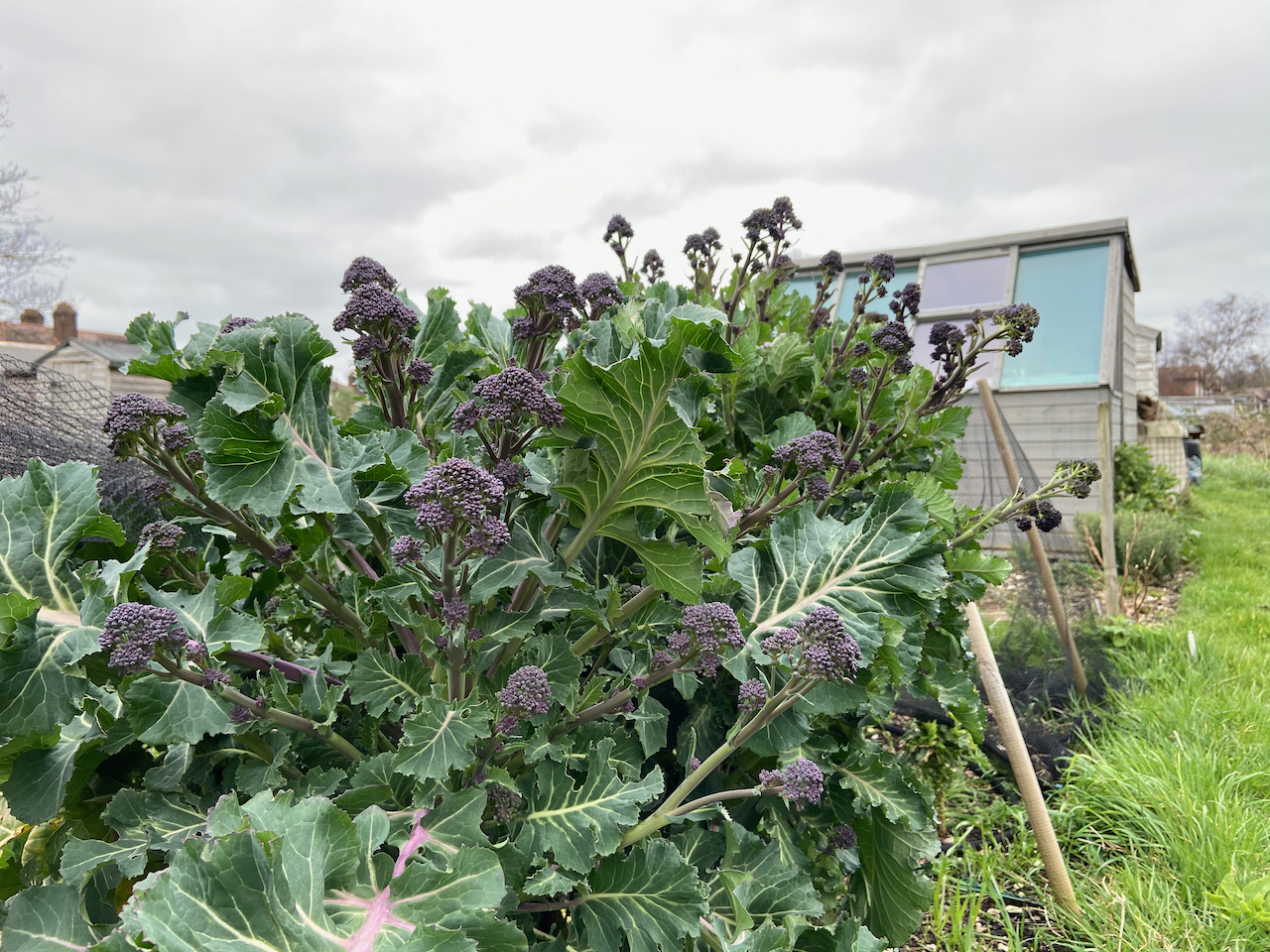
As a fan of the sweet taste of broccoli stems, I love them and I look forward eagerly to their main season in late-winter through to early-spring. The bit we eat is actually a fat set of flower buds ready to burst. Purple sprouting broccoli is a biennial plant like its relative wallflowers, Erysimum cheiri, and non-relative foxgloves, Digitalis purpurea. Growing leafy plants in the first year before flowering and setting seed in the second, unless you eat it first! (Purple sprouting broccoli that is, don’t eat foxgloves, they’re poisonous).
Sow purple sprouting broccoli seeds
Purple sprouting broccoli is sown in spring between March – June. The timing will depend on your area and when you would like them to crop. For me, here in London we’re in the milder south of the UK and we have the urban microclimate, so spring is generally earlier at some point in March.
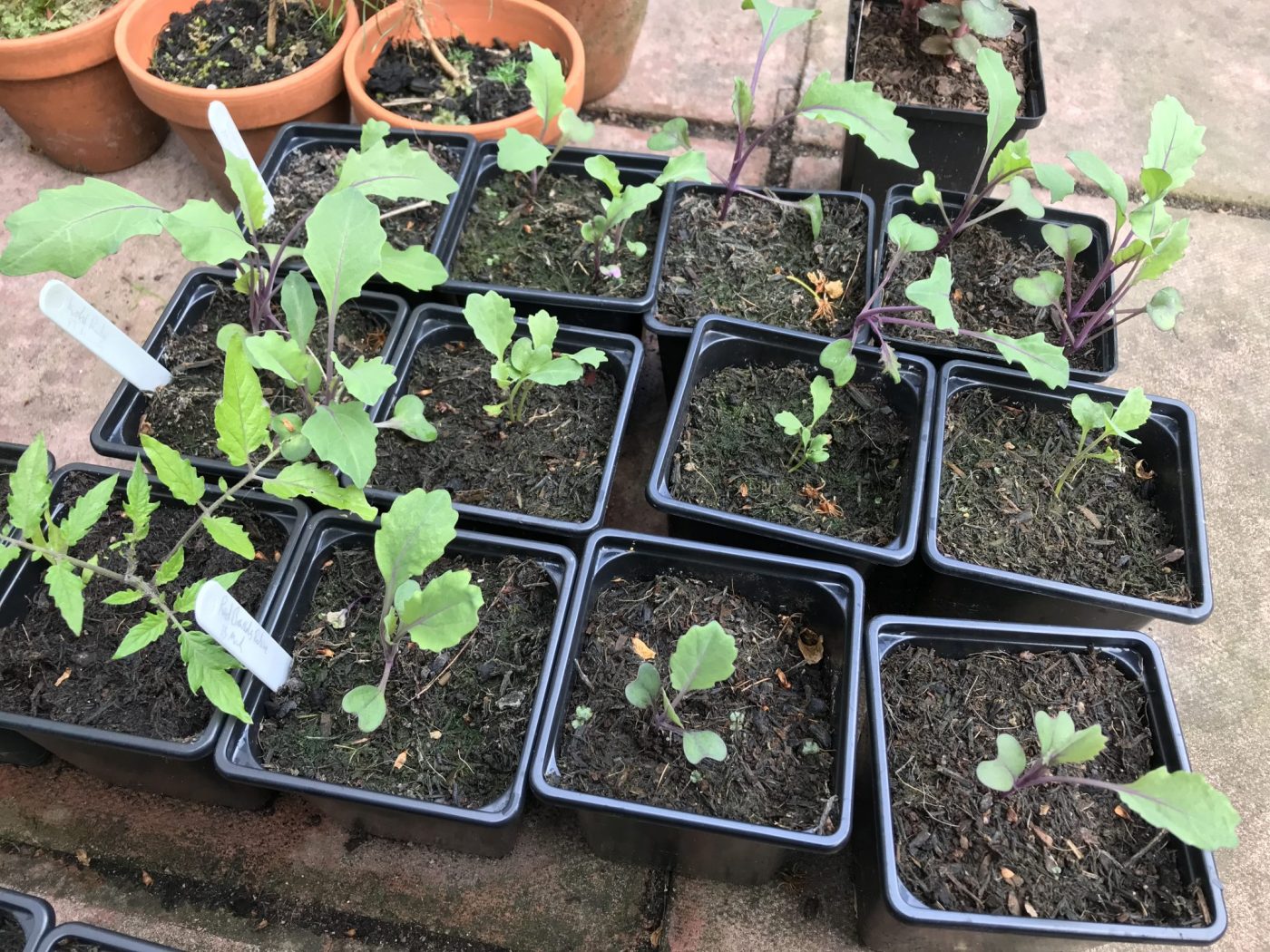
I aim to sow my seeds into pots of compost as soon as there are no more frosts and the night temperatures are stabilising close to 10C. If you are in colder areas, you will benefit from waiting until April or even May – light levels and daylight hours will be longer then too, the plants will quickly catch up.
Sow seeds into normal peat free compost at a depth of 2cm. The seeds are large and the plants strong so you don’t need seed compost for brassicas. Cover and water in gently, placing somewhere outside that is sheltered and in sunshine – again, if you’re in a colder area, consider growing on a windowsill, in a cold frame, polytunnel or greenhouse until weather warms.
You can sow the seeds into seeds trays initially to save space, carefully teasing out the seedlings when they have at least one set of true leaves (four leaves in total) and potting up into 9cm individual pots. Alternatively, save time as I do by sowing two seeds per 9cm pot, removing a step. I find brassicas grow so quickly and strongly it’s pretty pointless sowing into seeds trays.
Grow on the seedlings in these pots until they are about 10cm tall, looking healthy and have 6 – 8 leaves. Then you need to plant them out.
Alternatively, you can sow seeds directly outside where they are to grow or into a dedicated seed bed but I find this isn’t particularly convenient as most people don’t have space or they’re more vulnerable to slugs and snails.
Plant out seedlings
Around June or July, when seedlings are 10cm tall and looking strong, plant out at a spacing of 60cm between plants, they are large plants that need lots of space. Bury them ever so slightly deeper than they were growing in the pot for extra stability, roughly to where the first set of leaves are. Firm in carefully with your foot to give them a good solid base to grow from.

Purple sprouting broccoli needs to be planted in full sun in a sheltered site that isn’t too windy; they grow lankily and are subject to toppling over in strong winds damaging their roots. Though you can also stake them by adding strong bamboo canes and tying them using some natural twine.
They also need a rich, fertile soil which means adding a good 5 – 7cm layer of compost or well-rotted manure before you plant – ideally one to three months prior to planting out. To keep things simple, at the same time as sowing your seeds, then prepare the area you’re planning to later plant them into by adding the compost or manure to the surface, making sure it’s weed free of course. Worms will have incorporated it just enough by the time your seedlings are ready to plant out.
Feeding purple sprouting broccoli
Through the growing season give the plants an occasional glug of seaweed fertiliser or homemade nettle fertiliser, this will make them good strong plants for bigger crops in winter. Also consider adding a little dry feed around the time of planting and again in mid summer as a top up when the plants are quite large. I use free-range chicken manure pellets, though there are other fertilisers including powdered sea weed and blood, fish and bone. Scatter about on the surface to the ratios on the packets. I wouldn’t use the chemical fertilisers like Grow More personally because I prefer my veg and fruit to be organic.
Pinch out the main shoot in winter
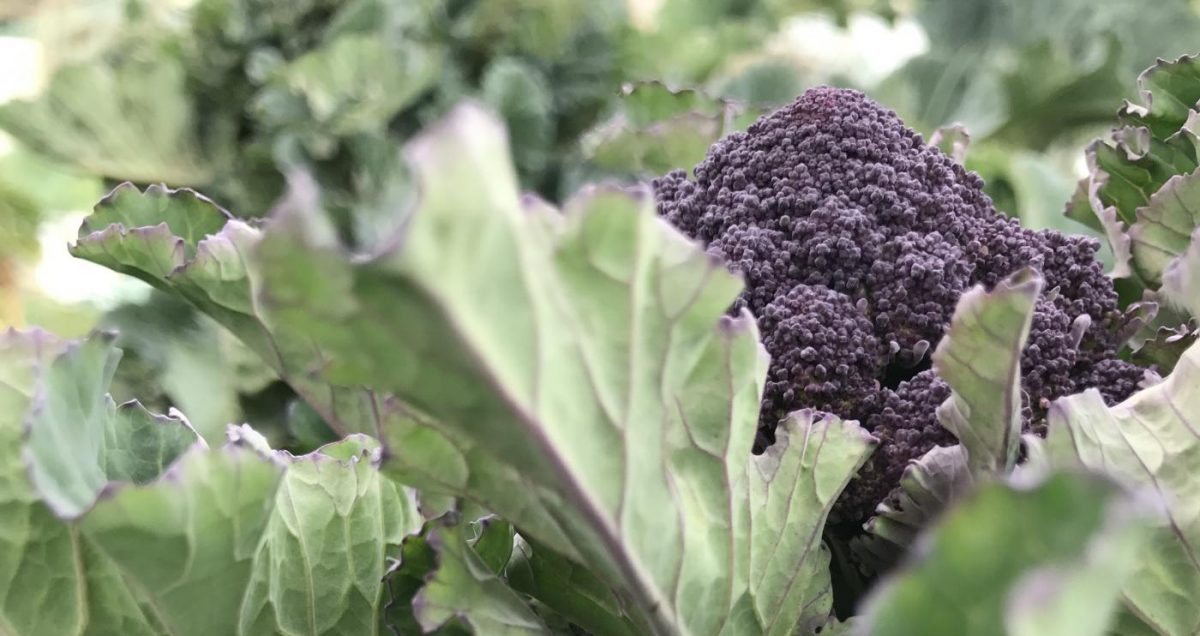
At some point in late winter you’ll spot the purple florets starting to form, at soon after seeing these, nip out the larger main growing point (shown above). Once you do this, it removes the growth suppressors in the plant’s main shoot allowing all of the lower shoots to then grow more strongly, leading to larger side shoots. They will suddenly grow very quickly too as the plant reacts. Of course, you an eat these main shoots as a special gardener’s only treat not available in shops – your first purple sprouting broccoli harvest of the year.
Which purple sprouting broccoli cultivars to grow?
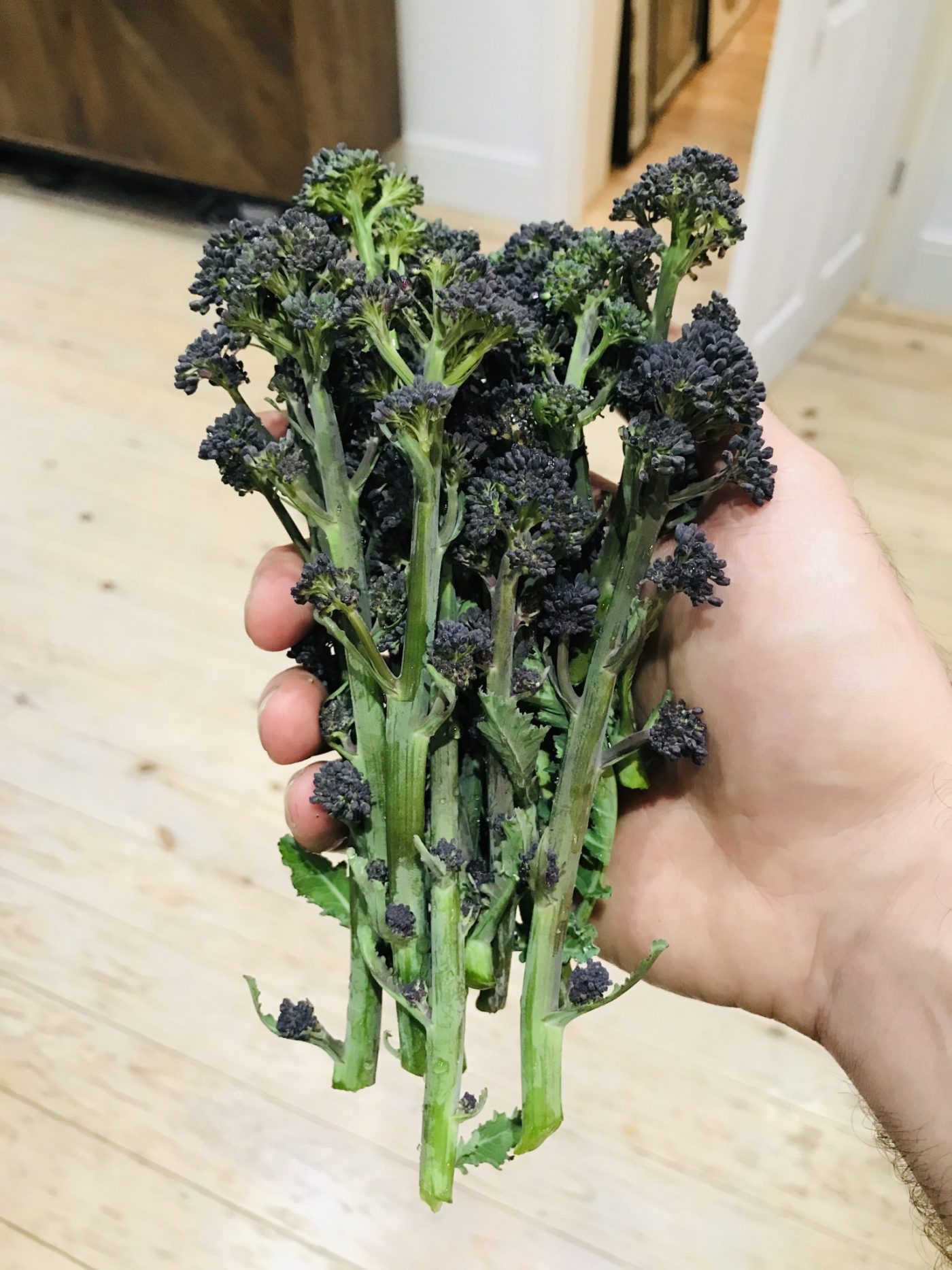
Having grown a number of different cultivars over the years, I find they are generally all very similar so you can’t really go wrong. Some of my favourites include:
- ‘Early Purple Sprouting’ – is my top pick because it’s a very strong grower with a good number of stems. The spears are chunkier too, which to me makes them nicer to eat and they also last longer stored in the fridge.
- ‘Red Arrow’ – produces a slightly higher number of less chunky spears. The floret elements are dotted all along the stem rather than amassed at the top. It’s a bit more of a refined type and is best for frying because the thinner stems cook easily and evenly.
- ‘Bordeaux’ – can be ready to harvest in summer if you sow early enough. I tend not to grow this as I enjoy the winter-spring seasonality of the plants. But don’t let me be a party pooper, if you love purple sprouting broccoli, grow this too!
How many plants to grow?
A good question and it depends completely on how much space you have and how much you love purple sprouting broccoli! As a guide, I grow four plants per year and Chris and I have approximately 15 – 16 portions for two people from those. It’s not exact as it depends on how strong the plant is.
I could easily grow much more than this. If you stagger sowing by weeks or months, they’ll crop at different times giving you a longer harvest period. In an ideal world I would think for a family of 2 – 4 people, you could grow between 8 – 16 plants for a good amount.
On my allotment I would struggle to grow more than four plants due to space as I like all of the brassica tribe and at 60cm spacing each and a 12 month growing cycle, these are space hoggers.
Protect purple sprouting from pests
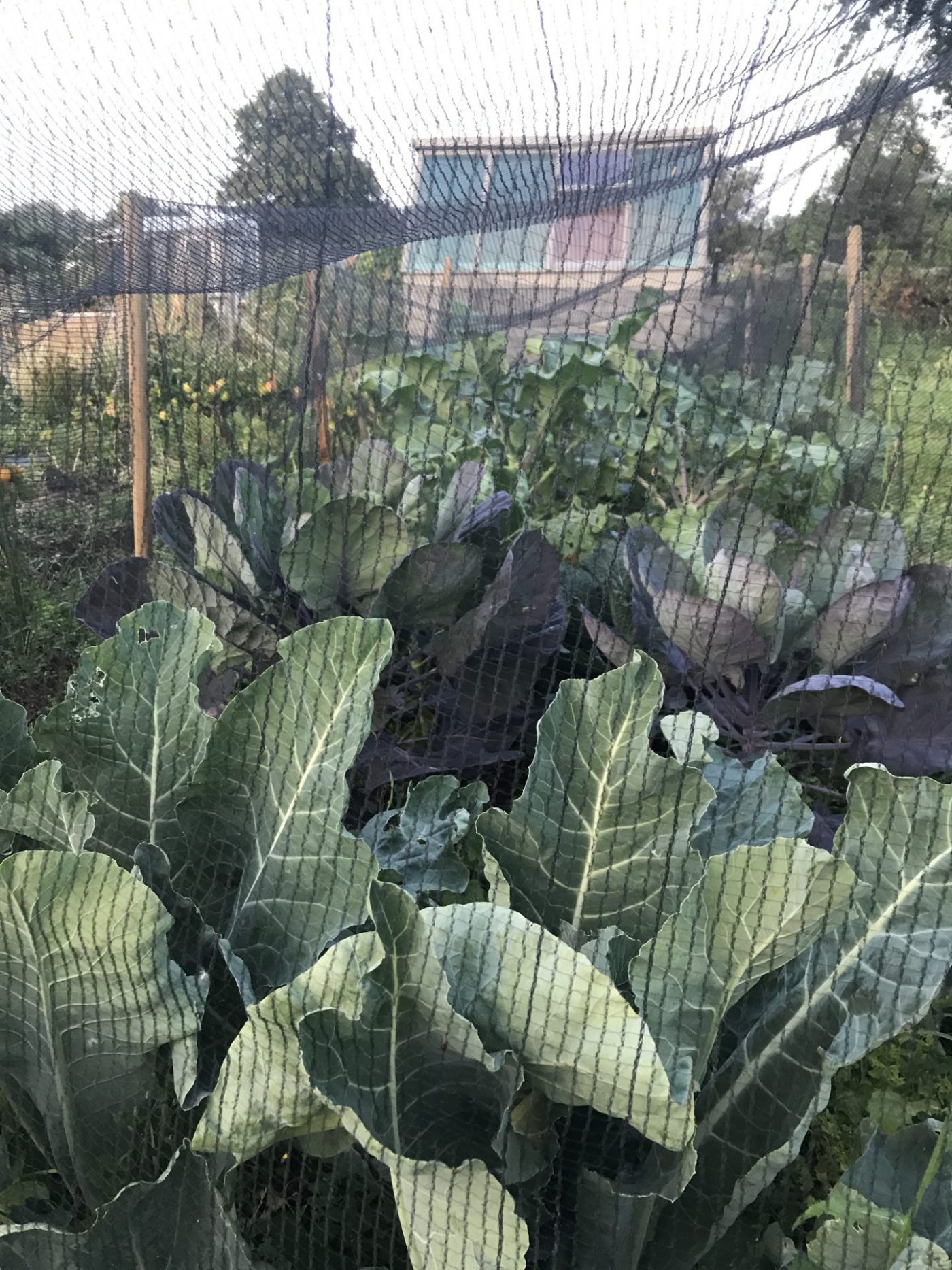
The main pests of purple sprouting broccoli are slugs and snails, pigeons and cabbage white butterfly caterpillars, all of which enjoy eating the plants as much as we do. I find the best way to stop almost all of these pests organically is to use a fine insect mesh as a barrier.
There are ready made products you can buy that will do the trick (search online for vegetable cages or netting). However, I go for the easiest option which is a set of 3cm thick garden stakes at 1.2m tall or higher. Whack these in every meter or so around the perimeter of the area you’re growing purple sprouting broccoli and other brassicas in, then throw the netting over it so it completely encases the area. Peg in at regular intervals. This approach even stops larger snails, solving a large part of that problem.
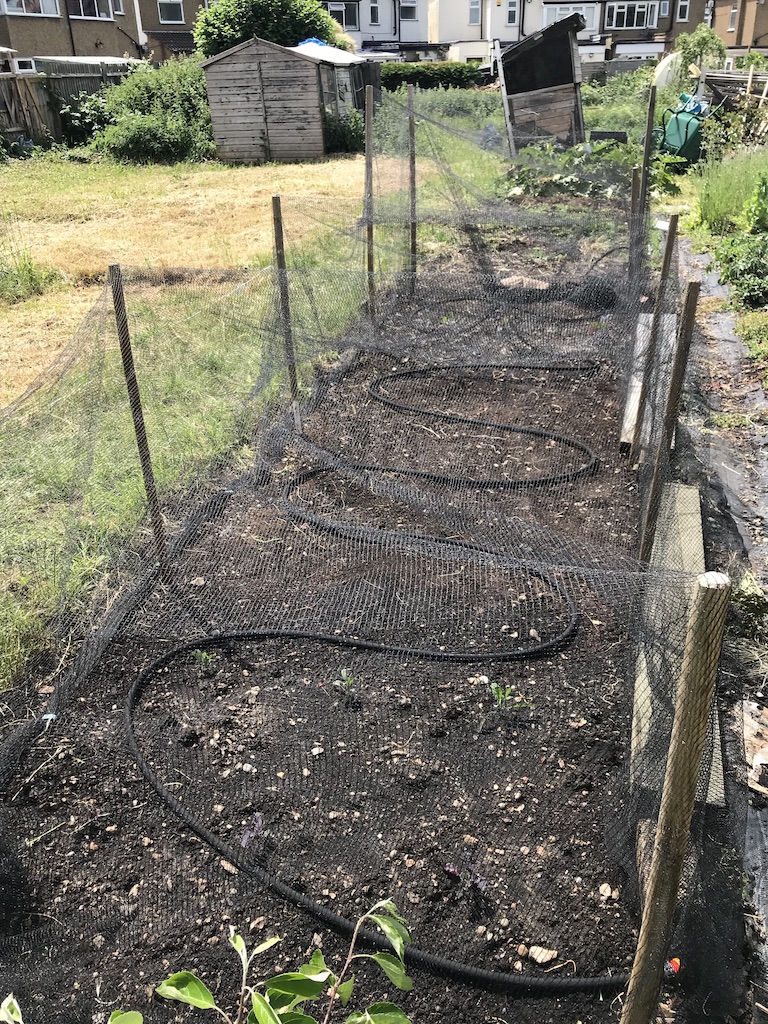
Whitefly is a problem on brassicas however, purple sprouting crops in winter when they are inactive so the bit you eat will be white fly free. Unlike other summer and autumn ready brassicas where they are a larger issue.
Netting makes it tricky to weed the area as you have to remove it every time you do but due to brassicas’ thuggish size, once they’re away they will shade out most weeds reducing the number of times you need to get in there.
Club root on purple sprouting broccoli
Club root is a fungal problem that can affect all brassicas and is the worst thing to happen to brassica growers. It causes lumpy, swollen and distorted looking roots that affect the growth of the plant. Unfortunately it can last for 20 years or more in the soil, so once you have it there is nothing you can do to get rid of it. Which could cause you to give up growing brassicas altogether.
The best thing is prevention, I will alway grow my brassicas from seed for this reason as it avoids importing the fungus in from other plants. Another reason to only use your own tools in your own garden or allotment to avoid accidentally bringing in problems from soils elsewhere.
If you find that you do have club root, things you can do include:
- Make soil more alkaline either by using spent mushroom compost for your mulch if it’s available or using granular gardening lime. Club root favours acidic soils, so making the soil slightly more alkaline can suppress it.
- Grow plants on in larger pots until reasonably strong before planting out, which can help but won’t stop it. This may be enough however for an edible crop.
Harvesting purple sprouting broccoli
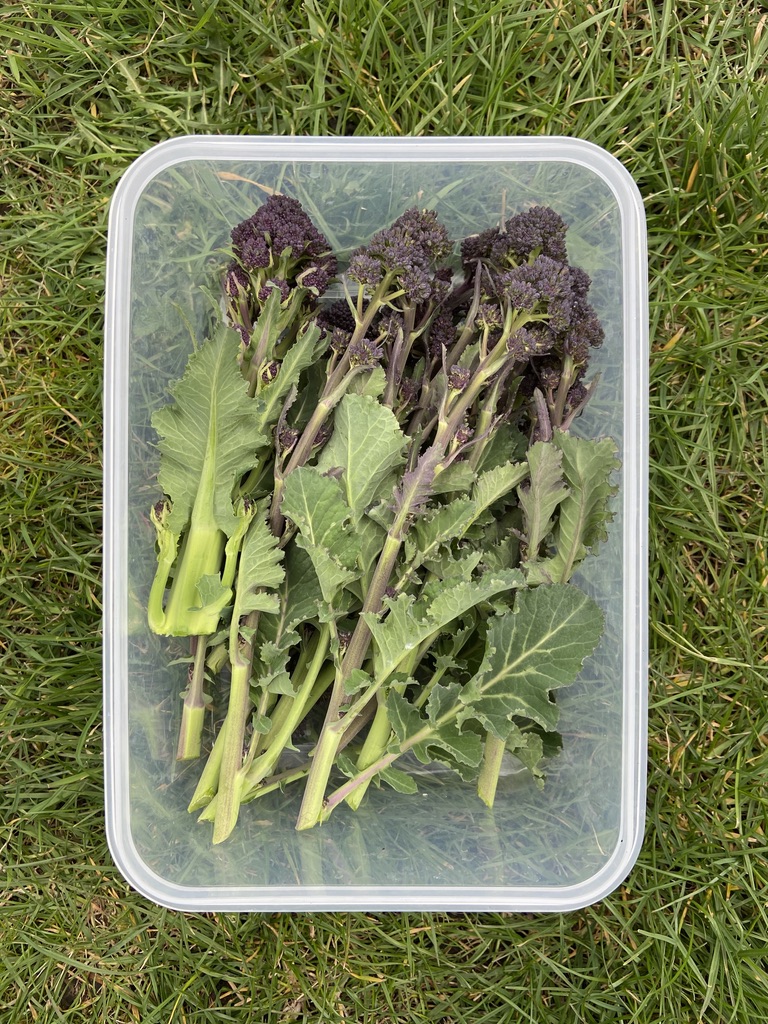
When purple sprouting broccoli is ready to harvest and eat depends on the cultivar you’ve chosen to grow and also when you sowed them. Sow them early in March (inside in cold areas) and you could be eating broccoli spears in early winter and even late summer with the right cultivar. Usually however, it’s around March – April when they are ready.
Harvesting is easy, you can see when ready because in late winter the purple florets emerge. Then they quickly elongate and the absolute perfect moment is when all of the flower buds are evenly sized. You’ll see if they’re not quite ready because the tips don’t quite look full enough, though they’re perfectly edible.

Cut off low down each spear to whatever size you like, trying to gauge where the stem stops being succulent and turns a little woody – obviously you can trim later so go further if unsure.
Personally, I leave all of the small leaves on the spears, they’re perfectly edible and tasty, adding to the volume of food.
How to cook purple sprouting broccoli
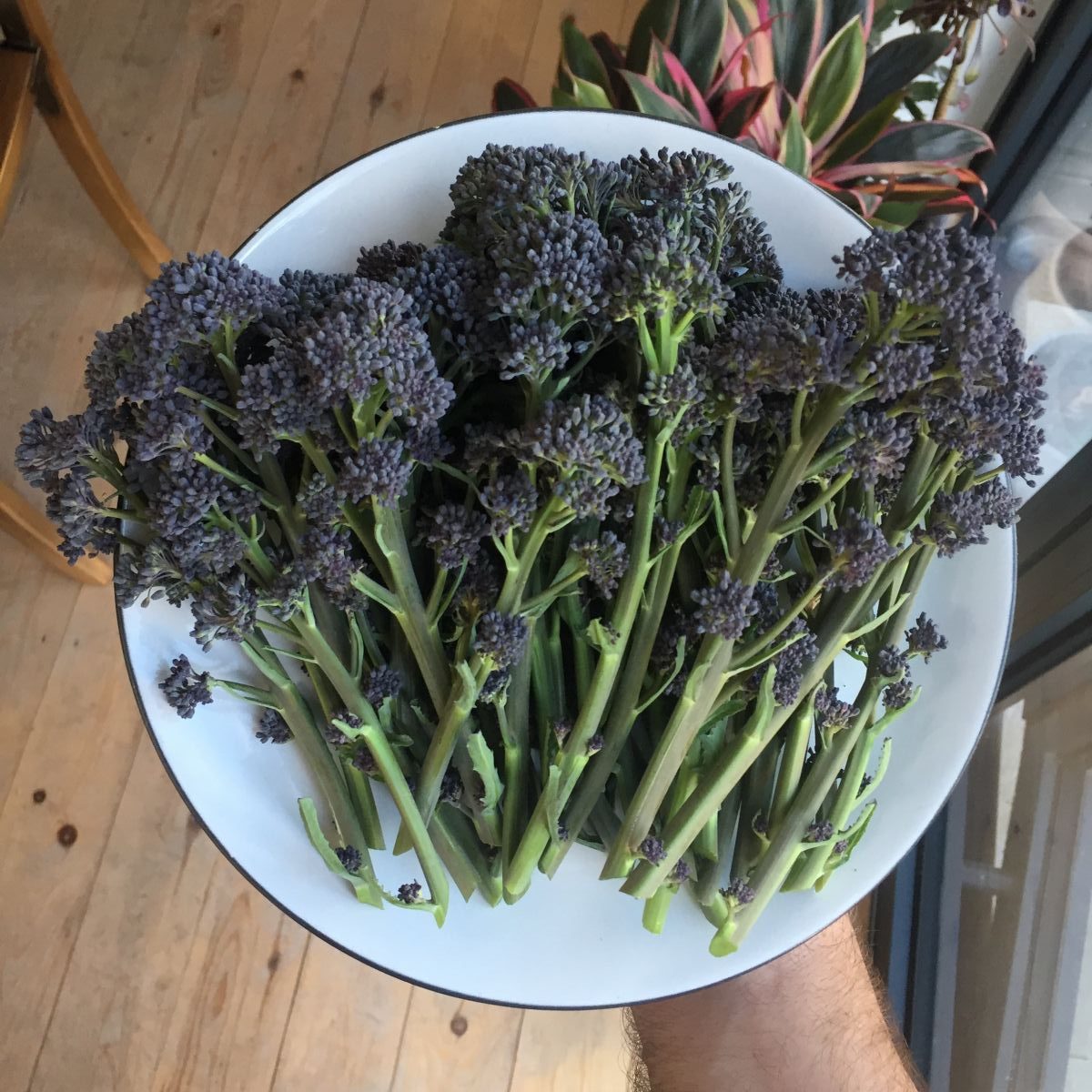
It’s a versatile vegetable and can be cooked in a whole variety of ways like many greens. Fried in garlic with sliced almonds at the end they can be cooked and eaten exactly like asparagus, with a poached egg or as a side. Add a little chilli for some spice.
Easiest is to boil for a few minutes or steam, steaming helping to minimise the risk of over cooking. Boiling will wash out most of the purple colour and the spears magically turn green – the purple rinse water looking particularly off putting!
I don’t mind boiling it, being very careful to only cook it just enough to tenderise without turning the florets to mush. I like quite a firm stem as it’s then also the sweetest.
There are other more elaborate recipes too if you are more daring than I in the kitchen, just search for purple sprouting broccoli recipes online.


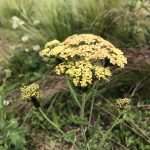

Hi Jack
I follow your blogs/sites etc and particularly liked your latest article about PS Broccoli. Some useful tips which I will take on board.
I’ve been an allotmenter for 10 years now and grown PSB for the last 5 yrs or more. 3 years ago I invested in a home made wooden structure that enables me to access my brassicas incl PSB, and Brussels without having to bend down – so it’s a shocking 2metre tall! All covered with net to keep out the pests. It looks a bit excessive but it really works. With a bit of help I move it around my plot so that I still get crop rotation.
Worth bearing in mind that PSB freezes well if like me you get a bit of a glut. I open freeze it then bag it up.
Keep well
Derek
Derek.sharland2@gmail.com
Hi Derek,
Thanks for sharing how you grow purple sprouting broccoli, that’s interesting and I can see the benefit even if the structure is tall!
And good tip about the freezing. In the end we opted for lots of broccoli soup which has been tasty this year 🙂
Keep well too.
Jack
I’ve been growing Purple Sprouting for at least 10 years in London so was interested to read your approach, Jack, of growing seedlings in pots. I’ve generally just planted a row of seeds in the ground and then transplanted the best plants during the summer to grow on through the winter. I only need about 6 or 8.
The problem with my approach is that it’s usually June or July when you have to transplant and the plants are big and need plenty of watering and shading from the sun until they re-establish.
Then during winter winds they tend to blow over, and only steel supports would be sufficient to hold them in place. That might still be the case with your approach but I’ll give it a try!
Hi Philip,
Thanks for sharing your experience. I know many vegetables like brassicas and leeks can be grown in seed beds outside but I find it much easier to start in seed trays or pots for a number of reasons.
Mainly, I just find it easier as once they’re large enough I can plonk into the ground just as they’re getting away which does help with establishing good root systems early on – good for watering and stability. However large plants like purple sprouting broccoli and Brussels sprouts do still need staking for me usually as they’re top heavy and my plot is quite exposed and windy. I never really have to water them though, except to encourage more growth in summer. You do have to be careful in the first month after planting because two years ago we had a very dry early summer and I lost a few plants.
The other reasons including protecting the seedlings from slugs and snails until large enough. I don’t have club root on my plot (touch wood) but I’m paranoid about it so I prefer growing the seedlings into strong little plants in compost and plant out at that point. It would never stop club root but it can help as a way of growing brassicas with it in the soil…. that entire last point is a bit ridiculous I know because I don’t have the problem.
I would always grow in pots for the slug and snail point, to keep a closer eye on them and to reduce the amount of soil being moved from one area of the plot/garden to another. I might feel differently if I had a large garden and grew everything at home.
Happy growing!
Jack
I am harvesting my purple sprouting now and would like to know if I cut them down after harvesting will they shoot again ready for next spring..
Hi Angela, I pick the shoots and leave for a week or two as sometimes more can grow. But if you aren’t seeing any in that time yank them out! Or if you need the space remove them too as you won’t get many more than the first crop.
I’ve been growing PSB for years. It always grows ridiculously tall and I get a goodish crop. But always feel it could be better as it NEVER grows side shoots and all the side leaves fall off. It’s always mostly around the top. It is never grown in the same place twice.
Is this because I am in an exposed area, is it the type (always Early), or something else? I can’t find any information about this online at all. Many thanks for any advice.
Best Michelle
Hi Michelle, do you stake them to keep them upright? You can try pinching out the main shoot toward the end of winter and that will force all of the side shoots to grow 🙂
Jack
Even when there isn’t any sign of purple heads? I do stake them.
Thanks for getting back to me. Much appreciated.
M
I’d do it at the first sign of the top flower shoot showing or before.
Does purple broc keep growing for does the plant die each year after crop.
Thanks
Mel
It dies / is taken out after the crop